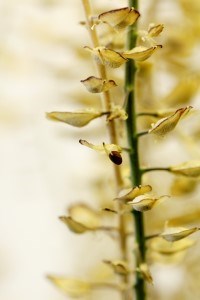Facts:
The study was funded by Mistra Biotech and published in Plant Cell Reports.

Seed oil with almost eight times more of the healthy oleic acid was the result when the researchers decreased the levels of two enzymes in the field cress (Lepidium campestre). This is an important step in the domestication process of this wild plant, rich in seeds and very winter hardy. The aim is to transform the field cress into a novel oilseed crop suitable for areas with colder conditions.
By decreasing the expression of two genes encoding enzymes that regulate the fatty acid composition, the level of the healthy fatty acid (oleic acid) in the oil of the field cress seeds was increased from 11 to 84 percent. At the same time the unhealthy erucic acid was reduced from 20 percent down to 0.1 percent. The linolenic acid was decreased from 40 percent to 2.6 percent. Linolenic acid is a healthy polyunsaturated fatty acid, but it is unstable at high temperatures.
– This improved oil is suitable for food processing now, especially for frying, says Li-Hua Zhu, professor in plant breeding and biotechnology at SLU, who leads this research project.
She explains that we need to produce more oil from plants – to replace the fossil oil used, for instance, in the chemical industry, and to get more healthy oils for human consumption. There is no oil crop that could tolerate the cold winters in the north of Sweden today, but the field cress, after being completely domesticated, could be cultivated throughout Sweden, and other parts of the world as well in the future.
Field cress has the potential to become a crop that would be excellent in several respects. It is a biennial plant and can function as a catch or cover crop – it ”catches” the nutrient fertilizers from the field or cover the field during the winter when the arable land would otherwise be bare. Field cress can be cultivated together with for example barley or wheat. The plant has around 20 percent seed oil, but the oil quality in the wild type field cress is not useful for food consumption due to its high level of erucic acid.
Emelie Ivarson is a PhD-student in the research project.
– The field cress has a relatively high content of oil in the seeds, but the composition of fatty acids in the oil of the wild field cress is not suitable as foodstuff. Therefore, we have altered the oil composition, Emelie Ivarson explains.
The study shows the possibility to use the field cress for genetic engineering of oils as tailor-made for various end uses.
Since fossil oil is environmentally non-sustainable and resources are depleting, it would be great if we could produce more plant oils for different purposes in our fields.
To develop the field cress into an economically viable crop, the researchers are now attempting to increase the oil content from 20 percent to levels around 30 percent. Winter oilseed rape is the major oilseed crop in Sweden and contains more than 40 percent seed oil, but it is only cultivated in southern Sweden due to its weak winter hardiness.
More information:
li-hua.zhu@slu.se +46 (0)40 - 415373
The study was funded by Mistra Biotech and published in Plant Cell Reports.
mistrabiotech@slu.se
+46 (0)18 672232
Ivarson, E., Ahlman, A., Lager, I., & Zhu, L. H. (2016). Significant increase of oleic acid level in the wild species Lepidium campestre through direct gene silencing. Plant Cell Reports, 35(10), 2055-2063